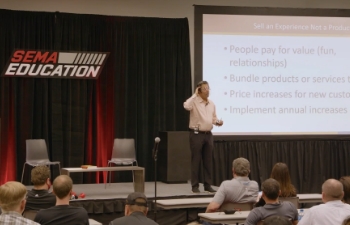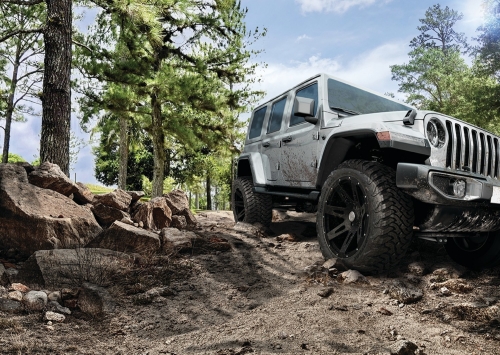SEMA News—October 2015
BUSINESS
By Mike Imlay
Retail Spotlight
Bert’s Mega Mall Cranks the Powersports Volume
 Bert’s was originally a bicycle store. Today, it is exclusively powersports. Under Ron Seidner, it has become a 250,000-sq.-ft. “mega mall” of motorcycles, watercraft and UTVs, ranking as the nation’s number-one powersports powerhouse. | |
Located in Covina, California, Bert’s Mega Mall has a celebrated reputation as the nation’s largest powersports super store. Originally a bicycle retailer, it was bought in 1958 by Ed Seidner, who kept the Bert’s name because he couldn’t afford to change the signage and business cards at the time. Soon Seidner was adding motorcycles to his inventory, becoming one of California’s first Yamaha franchises.
Ownership eventually passed to Seidner’s son Ron, who continued to expand the business with a wide range of powersports brands and lines. In 1997, he purchased and moved Bert’s into its current location, a massive “big box” store composed primarily of a former Target outlet and its Kids“R”Us neighbor, combining sales, service, parts, accessories and merchandizing under one roof.
SEMA News caught up with Seidner at his dealership to learn the secrets of his incredible success, which is built heavily on selection, inventory management and efficient customer follow-up.
SEMA News: We’re here in your store on a weekday morning, and we see a lot of customers. What is your daily foot traffic?
Ron Seidner: You know, I really haven’t done a count. It’s hard to give numbers, but this store sells an average of 15 units a day and in the 30s to 40s on weekends. We’re selling every day of the week, and our service department is cranking. We do personal watercraft, three lines of jet skis, three lines of jet boats, UTVs such as the Polaris RZR, Yamaha Rhino or Viking, and then all the street bikes, dirt bikes and ATVs, new and used—13 brands.
SN: Your mega mall is rather unique in the industry. What is the actual size and scope of your facility?
RS: This building is a [former] Target store, and our showroom and total dealership footprint is 250,000 sq. ft. on nine acres. Our service department was once a Kids“R”Us clothing store next door to the Target store showroom, where we now sell our vehicles, parts and accessories. We also have a coffee lounge and five customer lounges where people can sit and relax with their kids when they come into the shop. We have first-class restrooms, around 300 parking stalls and storage out back where people can drop stuff off. We’re open seven days a week, closed five holidays a year and employ about 212 people.
SN: What is the extent of your success? Can you give us an idea of your sales figures?
 Smart inventory management is the cornerstone of Seidner’s success. Bert’s is a massive candy store of powersports vehicles of every variety. These bikes and UTVs are only a small sampling. | |
RS: In the big days, our sales were somewhere around $120 million a year. Now we’re 30% to 40% in back of that because of the recession—the way the credit market tightened up and the unemployment that everyone experienced. We’re seeing [upward growth] as jobs begin to get better out there.
SN: Despite the recession, your business remains strong. Can you share three top business practices that have led to your success?
RS: First, I cut from the bottom up when the free-fall came. I kept my best soldiers. That was huge, because that’s where my strength was. Second, I modified my buying but did not modify my selection. When another guy would eliminate one color or two colors or one model, I continued to have my inventory available, and I was able to financially go through that time period, too, because we’re fairly stable. Having the inventory and selection you see is everything. Finally, the biggest thing is the footprint of this dealership. A guy comes in here and instead of being like another store saying they have one in the warehouse, can get it in a week or transfer it in, people want to buy it in a day. We make that available.
SN: Let’s talk about that inventory. How were you able to grow your footprint so large?
RS: Through the early days, when we moved to this building, our sales literally went up 80% because of the way we merchandized and stocked and staffed it. I didn’t spend a lot of money. I didn’t make any stupid investments, and I invested only back into it. If I sold eight, I bought 12. If I sold 12, I bought 20. At 20, 100. Before you knew it, I had inventory and just kept it growing to the point where my sales were following my inventory levels.
SN: What were the risks along the way?
RS: Our old store, where we were for 30 years, was 53,000 sq. ft. when we moved out with 68 employees. When I moved in here, we had 250,000 sq. ft. and, within 12 months, we picked up 80 employees. That was 80 people we had to bring in and train, and, of course, we had to fill the building. So we started pressing the inventory, and people came into the store and liked the selection and the way we dealt with people and followed things up and hustled.
| Executive Summary |
| Bert’s Mega Mall 1151 N. Azusa Ave. Covina, CA 91722 626-974-6600 www.bertsmegamall.com
|
With buying, there are always a couple of dogs in every group. When we get to the point where we buy a dog—say I end up with two part numbers that I thought would be good and they’re not—I ride them down, take a financial hit on them, work the tax benefit and blow them out, get my investment back, and I don’t buy them again. Having 13 lines, there’s always two or three like that, but we’ve been fortunate enough to be able to manage that through the years.
I’ve never been one to keep a vehicle on the floor for four years. When it comes due, I want to pay it off and get my investment back. I’ve kept sharp that way. I think a lot of dealers, on the downside, aren’t able to do that. They keep something in stock three years, paying 12% to 14% interest and sell it for a $300 or $400 deal when it costs them four grand.
It’s the message my dad taught me: Your first hit is your best hit. Take it and go. The trick of the game is to manage your inventory properly, burn it before you pay the juice on it, and not start working to get it out of the door after that point.
SN: Your dealership is more than sales, though. You also have service and retail departments that could easily stand on their own.
RS: We’re one of the only dealers in the powersports industry to have a complete auto-type service department. People can drop off boats, trailers, cycles, side-by-sides. It takes a lot of room. When a guy tries to drop a motorcycle off, a lot of dealers will say they can’t take it in since there’s no place to put it. Space is everything, and then we have about 24 trained technicians, a service director, a dispatch manager and a writer, same as the auto industry.
We also have a huge parts and accessories department. Different from the auto industry, we stock all the clothing a guy might wear. Here we have goggles, gloves, helmets, tinted shields, boots, the leather suit and then the lifestyle clothing afterwards—shorts, T-shirts, Oakley sunglasses. We also have a lot of aftermarket parts and accessories that an auto dealership doesn’t share in as well as in-house customizing, which most auto dealerships don’t do. That’s probably the biggest [advantage we have] over an auto dealership—the parts and accessory lines that we can carry.
SN: With so much inventory and staff, how do you keep things moving?
RS: We’re just aggressive. We’re aggressive in our online advertising and the credit applications coming in. We try to press the follow-up and phone calls, which you know in the auto, motorcycle and just about any business is horrible anymore, getting people to call you back. So we push real hard on that every day.








